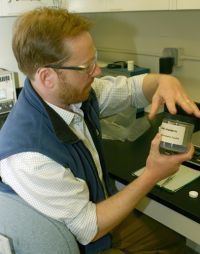Scientists seek marijuana`s isotopic fingerprint
Scientists at the Alaska Stable Isotope Facility, University of Alaska Fairbanks (UAF) can tell whether marijuana confiscated in a traffic stop in Fairbanks likely came from Mexico or the Matanuska Valley.
Scientists at the Alaska Stable Isotope Facility, University of Alaska Fairbanks (UAF) can tell whether marijuana confiscated in a traffic stop in Fairbanks likely came from Mexico or the Matanuska Valley.
Furthermore, the team of scientists carrying out the project believe than in only a few more years, once more samples have been studied, they will have something even more precise: an elemental fingerprint that could tell police where and under what conditions a sample of marijuana was grown.
We hope to determine whether marijuana was grown indoors or out, said Professor Matthew Wooller, Alaska Stable Isotope Facility director.
“There are scientists already doing this for drugs like heroin and cocaine. The potential is there for being able to do this for marijuana as well.”
The key lies at the atomic level. Of particular interest to Prof Wooller and his colleagues are the stable isotopes of four elements: carbon, oxygen, nitrogen and hydrogen.
Isotopes are atoms of elements that have the same number of protons and electrons but different numbers of neutrons, Prof Wooller explained.
A stable isotope is one that doesn`t decay over time. Those additional or missing neutrons in an isotope slightly alter the mass of the atom, allowing scientists to use a stable isotope ratio mass spectrometer to separate the light isotopes from the heavy ones and form a ratio for each sample. That ratio can tell scientists about the sample and its origins.
Prof Wooller said the marijuana holds a signature of the environment that it used to be grown in.
It is laid down in time and preserved in the materials that make up a plant.”
He added: For example, oxygen and hydrogen ratios can reveal information about the water a plant used while growing and, as a result, where it was grown. Water in Alaska and other high latitudes generally has a larger proportion of light oxygen and hydrogen stable isotopes than water from locations at lower latitudes.
Carbon tells another story, he said. It can offer information on whether a plant was grown outdoors or inside. Nitrogen could provide even more information.
The testing at the UAF facility is novel because, for each sample, scientists are taking the isotopic signatures of four elements, rather than for just a single one.
“We have the potential to create a precise chemical fingerprint, said Prof Wooller.
The teams research began approximately two years ago and was initially supported by a grant from the University of Alaska President`s Special Projects Fund. The UAF Police Department provided the lab samples of marijuana confiscated locally.
Prof Wooller said the project started off running samples of unknown origin, which yielded some surprising results.
Scientists initially assumed that most of the samples would show that they had been grown in Alaska rather than being imported from the low latitudes. “In fact, what we saw is there are samples that are almost certainly grown in high latitude,” said Prof Wooller. “Then you had marijuana that was clearly grown at lower latitudes.”
Since its launch, the project has expanded beyond samples of unknown origin. The federal Drug Enforcement Administration and the Alaska Bureau of Alcohol and Drug Enforcement have started providing samples from grows in Alaska.
Prof Wooller hopes that, with enough of those samples, he can create a marijuana isotope map for Alaska and beyond, which could eventually allow scientists to match unknown samples with known growing locations.
The project has potential to help police on multiple levels, according to Investigator Stephen Goetz at the UAF Police Department.
From an evidentiary standpoint, it could tie a growing operation to marijuana seized on the street, and offer evidence of both the production of marijuana and its distribution, he said.
The common denominator that people use as their defence is that they are growing it for their personal use on


